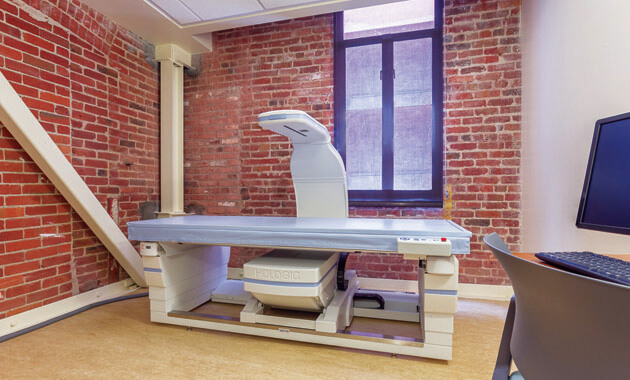Bone Density Scan (DXA or DEXA)
Dual-energy X-ray absorptiometry (DXA or DEXA) is a scan that is used to determine the density of bone to assess its strength. It is a standard method for diagnosing osteoporosis; used in combination with risk factors (the so-called “FRAX” method), it is also considered an accurate way to estimate fracture risk.
DXA works by sending two low-dose X-rays which are absorbed differently by bones and soft tissues. The density profiles from these X-rays are used to calculate bone mineral density. The lower the density, the greater the risk of fracture. DXA is painless and takes about 10 minutes. The amount of radiation is very low, about 10 percent of a normal chest X-ray.
DXA can determine bone mineral density for any bone but is most commonly used for hip and lumbar (lower) spine. The examination can also be used to perform vertebral fracture assessment. This screening is used to uncover bone problems of the skeleton, for example in people who have unexplained back pain or who have experienced a loss in height of more than an inch in a year. Vertebral fractures are often asymptomatic.
A bone mineral density assessment may be considered every two years, depending on age, gender, and other factors. See below for specific recommendations.
Osteoporosis Screening
According to the International Osteoporosis Foundation, osteoporosis is estimated to affect 200 million women worldwide. Men also experience the condition, which weakens bones and makes them subject to fracture. Though more women than men have osteoporosis, men are more likely than women to die after breaking a hip.
Regular screening can diagnose osteoporosis and other bone problems early. That way they can be managed and even curbed with prescription medicines and lifestyle modifications.
How important is bone health?
Assessing your bone health may not seem like a critical health priority but consider these facts:
- In women over 45, osteoporosis accounts for more days hospitalized than diabetes, myocardial infarction, and breast cancer.
- The overall mortality is about 20 percent in the first 12 months after hip fracture.
- About 20-25 percent of hip fractures occur in men. Men who break a hip are more likely to die than women who do the same.
Clinical Indications
There are a number of conditions related to poor bone health. People who should consider assessment with DXA include:
- Women 65 and older and men over age 70
- Women under age 65 and men ages 50 - 70 who have risk factors such as:
- A fracture over age 50
- Rheumatoid arthritis or chronic kidney disease
- Eating disorders
- Early menopause (from natural causes or surgery)
- History of hormone treatment for prostate or breast cancer
- Significant loss in height
- Smoking
- Family history of osteoporosis
- Taking corticosteroids (prednisone, methylprednisolone) every day for 3 months or more
- Three or more alcoholic drinks per day on most days.
Benefits of DXA at UCSF
UCSF researchers and physicians are among the world’s leaders in bone health.
- UCSF pioneered the use of DXA to assess bone health
- Offering swift and painless procedure
- Interdisciplinary team allows for the most comprehensive treatment plan to prevent further bone loss or injury.
Research and Collaboration Help
UCSF researchers work collaboratively with other departments to find out how to reduce the likelihood of osteoporosis. Learn more about the Bone Quality Research Lab (Principal Investigator Galateia J. Kazakia, PhD). The UCSF Skeletal Health Service is a collaboration of specialists in metabolic bone, endocrinology, rheumatology, and nephrology providing clinics at the Orthopaedic Institute.
















